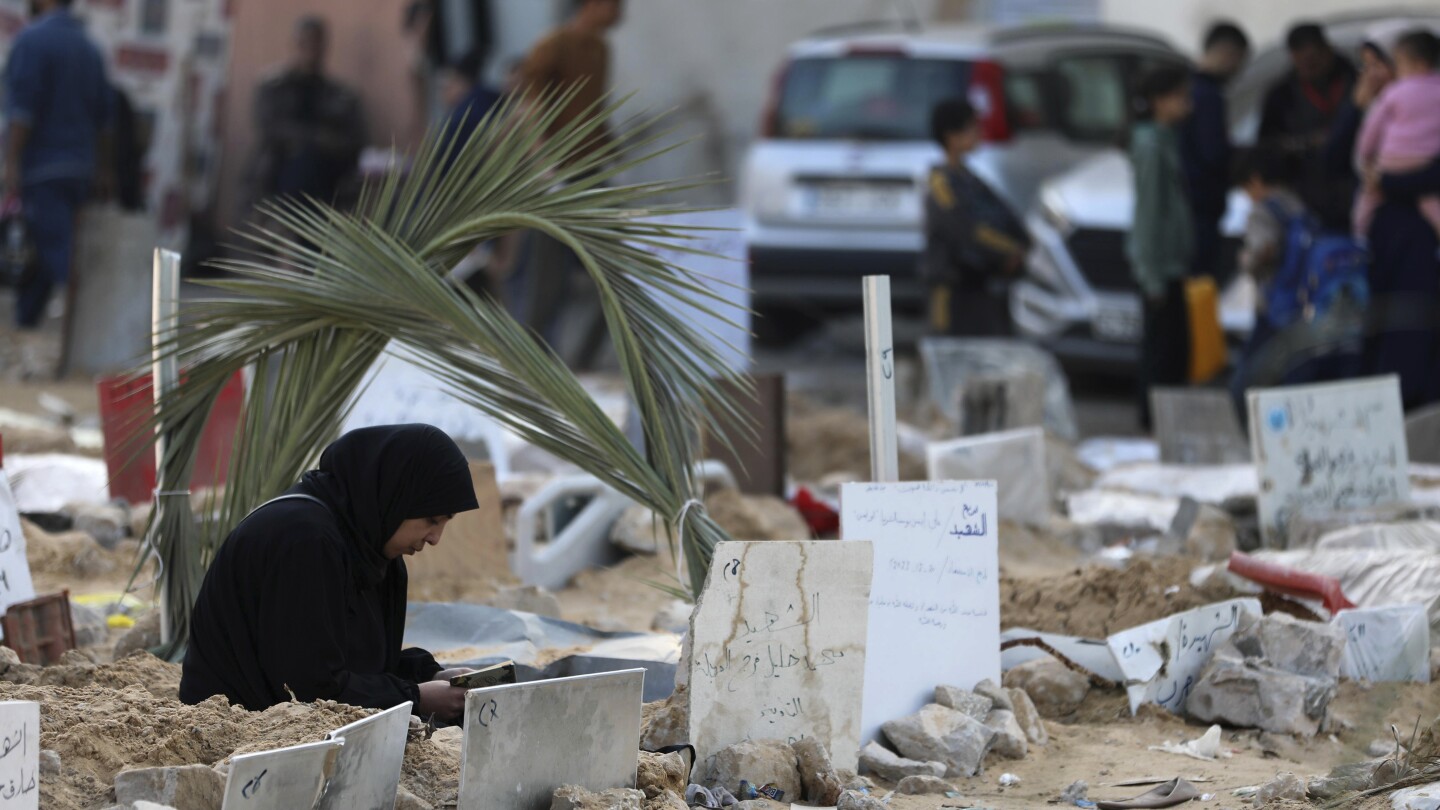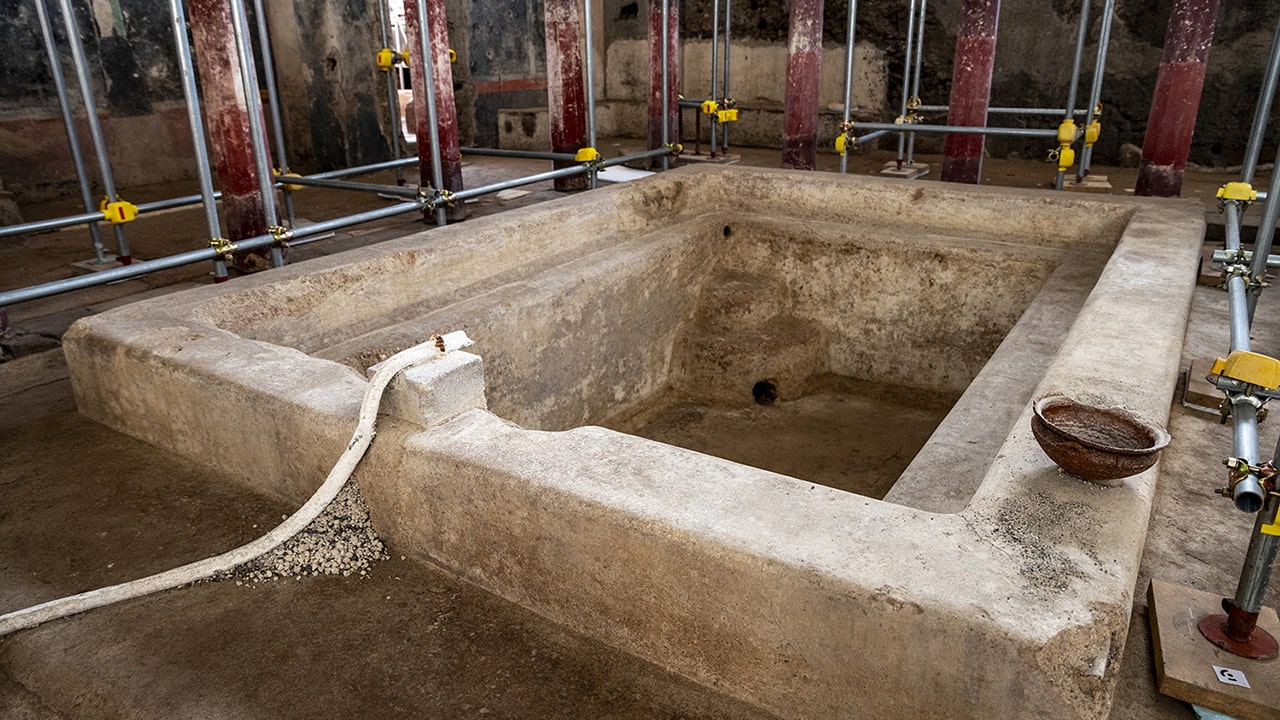World
Israeli strikes in central Gaza kill at least 35 as Netanyahu says war will continue for months

DEIR AL-BALAH, Gaza Strip (AP) — Israeli strikes in central Gaza killed at least 35 people Sunday, hospital officials said, as fighting raged across the tiny enclave a day after Israel’s prime minister said the war will continue for “many more months,” resisting international calls for a cease-fire.
The military said Israeli forces were operating in Gaza’s second-largest city, Khan Younis, and residents reported strikes in the central region, the latest focus of the nearly three-month air and ground war that has now engulfed most of the territory.
The war has raised fears of a broader regional conflagration. The U.S. military said Sunday that its forces shot and killed several Iran-backed Houthi rebels when they tried to attack a cargo ship in the Red Sea, an escalation in a maritime conflict linked to the war in Gaza.
Israel says it wants to destroy Hamas’ governing and military capabilities in Gaza, from where it launched its Oct. 7 attack on southern Israel. The militants killed some 1,200 people and took 240 others hostage after breaking through Israel’s extensive border defenses, shattering its sense of security.
Israel’s unprecedented air and ground offensive has killed more than 21,800 Palestinians and wounded more than 55,000 others, according to the Health Ministry in Hamas-ruled Gaza. The war has sparked a humanitarian crisis, with a quarter of Gaza residents facing starvation, according to the United Nations. Israel’s bombardments have levelled vast swaths of the territory, making parts uninhabitable and displacing some 85% of Gaza’s 2.3 million residents.
ISRAEL PRESSES ON
Israel expanded its offensive to central Gaza this week, targeting a belt of dense, built-up communities that house refugees from the war surrounding Israel’s creation in 1948 and their descendants. The fighting has pushed much of the population south, where people have flooded shelters and tent camps near the border with Egypt, even as Israel has also struck those areas.
In the area of Zweida in central Gaza, an Israeli airstrike killed at least 13 people and wounded dozens of others, according to witnesses. The bodies were draped in white plastic and laid out in front of a hospital, where prayers were held before burial.
“They were innocent people,” said Hussein Siam, whose relatives were among the dead. “Israeli warplanes bombarded the whole family.”
Officials from Al-Aqsa Hospital in central Deir al-Balah said the 13 were among 35 bodies received on Sunday.
The Israeli military said it was battling militants in Khan Younis, where Israel believes Hamas leaders are hiding. It also said its forces operating in the urban Shati refugee camp, in northern Gaza, found a bomb in a kindergarten and defused it. Hamas continued to launch rockets toward southern Israel.
Israel has faced stiff resistance from Hamas since it began its ground offensive in late October, and the military says 172 soldiers have been killed during that time.
THE DAY AFTER FOR GAZA
The magnitude of the destruction in Gaza coupled with the war’s length has raised questions about whether Israel can succeed in its goal of dismantling Hamas and what would come after.
Israeli Prime Minister Benjamin Netanyahu has said Israel must maintain open-ended security control over the Gaza Strip. At a news conference Saturday, he said the war would continue for “many more months” and that Israel would assume control of the Gaza side of the border with Egypt.
“(It) must be in our hands, it must be sealed. It’s clear that any other agreement will not guarantee the demilitarization that we need and require,” Netanyahu said. Israel says Hamas has smuggled weapons from Egypt, but Egypt is likely to oppose any Israeli military presence there.
Netanyahu has also said he won’t allow the internationally-backed Palestinian Authority, which administers some parts of the West Bank, to participate in any future rule over Gaza, putting him at odds with President Joe Biden’s administration, which has provided crucial military aid for the offensive.
The U.S. wants a unified Palestinian government to run both Gaza and parts of the Israeli-occupied West Bank as a precursor to eventual statehood. The last Israeli-Palestinian peace talks broke down over a decade ago, and Israeli government since then have been staunchly opposed to Palestinian statehood.
Israeli media have reported that Netanyahu has repeatedly dodged holding meetings with his War Cabinet about the post-war possibilities.
ISRAELIS PROTEST
Israelis, who still largely stand behind the war’s goals, are showing signs they are losing patience.
On Saturday night, thousands took part in one of the largest demonstrations against Netanyahu since the war began. The country, which is sharply divided over the long-serving leader and a judicial overhaul plan he set in motion before the war, has remained mostly united since Oct. 7.
“It is true that the state of Israel has many enemies and threats, but unfortunately today Prime Minister Netanyahu and his continued rule is the most significant existential threat to our country and our society,” said protester Gal Tzur.
A separate protest Saturday called for the release of the estimated 129 remaining hostages held by Hamas. Families of hostages and their supporters have demanded that the government prioritize hostage releases over other war objectives, and have staged large protests every weekend.
Egypt, one of the mediators between Israel and Hamas, has proposed a multistage plan that would kick off with a swap of hostages for prisoners, accompanied by a temporary cease-fire. A similar deal in November saw Hamas free over 100 hostages and Israel release 240 Palestinian prisoners.
But the sides still appear far from striking a new deal. Both Hamas and the smaller Islamic Jihad militant group say no more hostages will be freed until Israel ends the offensive and withdraws from Gaza.
___
Mroue reported from Beirut and Goldenberg from Tel Aviv, Israel. Associated Press writer Melanie Lidman in Jerusalem contributed to this report.
___
Find more of AP’s coverage at https://apnews.com/hub/israel-hamas-war

World
Cartier owner Richemont posts 10% increase in Q3 sales

World
Ancient Pompeii excavation uncovers lavish private bath complex

Archaeologists have unearthed a lavish private bath complex in Pompeii, highlighting the wealth and grandeur of the ancient Roman city before it was destroyed by Mount Vesuvius in AD 79, the site said on Friday.
The baths, featuring hot, warm and cold rooms, could host up to 30 guests, allowing them to relax before heading into an adjacent, black-walled banquet hall, decorated with scenes from Greek mythology.
ITALY’S ANCIENT POMPEII PARK CRACKS DOWN ON DAILY VISITORS TO COMBAT OVERTOURISM
The pleasure complex lies inside a grand residence that has been uncovered over the last two years during excavations that have revealed the opulent city’s multifaceted social life before Vesuvius buried it under a thick, suffocating blanket of ash.
A central courtyard with a large basin adds to the splendour of the house, which is believed to have been owned by a member of Pompeii’s elite in its final years.
“This discovery underscores how Roman houses were more than private residences, they were stages for public life and self-promotion,” said Gabriel Zuchtriegel, director of the Pompeii Archaeological Park.
The private thermal baths complex discovered by archaeologists in a villa of the ancient city of Pompeii is seen in Pompeii, Italy, in this undated handout picture released on January 17, 2025. (Pompeii Archeological Park/Ministry of Cultural Heritage and Activities and Tourism/Handout via REUTERS )
Zuchtriegel said the layout recalled scenes from the Roman novel “The Satyricon”, where banquets and baths were central to displays of wealth and status.
Decorated with frescoes, the complex draws inspiration from Greek culture, emphasizing themes of leisure and erudition.
“The homeowner sought to create a spectacle, transforming their home into a Greek-style palace and gymnasium,” Zuchtriegel said.
The remains of more than 1,000 victims have been found during excavations in Pompeii, including two bodies inside the private residence with the bathhouse – a woman, aged between 35-50, who was clutching jewellery and coins, and a younger man.
The discovery of their bodies was announced last year.
World
‘Fields were solitary’: Migration raids send chill across rural California

Los Angeles, California — Recent raids carried out by the United States Customs and Border Protection (CBP) in a rural California county have struck fear into immigrant communities as President-elect Donald Trump prepares to return to the White House.
CBP says that the operation in Kern County, which took place over three days in early January, resulted in the detention of 78 people. The United Farm Workers (UFW) union says it believes the number is closer to 200.
“The fields were almost solitary the day after the raids,” a 38-year-old undocumented farmworker named Alejanda, who declined to give her last name, said of the aftermath.
She explained that many workers stayed home out of fear. “This time of year, the orchards are usually full of people, but it felt like I was by myself when I returned to work.”
The raids are being seen by local labourers and organisations like UFW as a shot across the bow from immigration enforcement agencies before Trump’s inauguration on Monday.
His second term as president is expected to ring in a new era of enhanced restrictions and deportation efforts.
While the number of people arrested represents a small fraction of the hundreds of thousands of undocumented workers underpinning California’s agricultural sector, the anxieties caused by such raids extend far beyond those detained.
“On Wednesday [the day after the raids], I stayed home from work. I barely left my house,” said Alejanda, adding that she kept her five-year-old son home from daycare rather than risk driving to drop him off.
“Everyone is talking about what happened. Everyone is afraid, including me. I didn’t actually see any of the agents myself, but you still feel the tension.”
Emboldened agencies
Following a presidential campaign where he routinely depicted undocumented migrants as “criminals” and “animals”, Trump will likely try to fulfill his promise to carry out the “largest deportation programme” in the country’s history on his first day in office.
About 11 million people live in the United States without legal documentation, some of whom have worked in the country for decades, building families and communities.
The January arrests in Kern County appear to be the first large-scale Border Patrol raid in California since Trump’s victory in the November election, which set off speculation about the potential impact of mass deportations on immigrant communities and the economic sectors dependent on their labour.
About 50 percent of California’s agricultural workforce is made up of undocumented immigrants.
In California, undocumented status has been cited as a source of persistent anxiety for workers — as well as a means of leverage for employers, who often pay such labourers lower wages and grant them fewer protections in the fields.
But Alejanda says that workplace raids like the ones that took place in Kern County have not been common in the area.
“I have been here for five years and never experienced anything like this before,” she said, noting that workers were detained while leaving the fields to go home.
CBP said in a statement that the operation, named “Return to Sender”, had targeted undocumented people with criminal backgrounds and connections to criminal organisations.
#WeFeedYou pic.twitter.com/8e6GE9RRkK
— United Farm Workers (@UFWupdates) January 11, 2025
The raids were carried out by agents from the CBP El Centro Sector, located near the border between Mexico and southern California, more than five hours by car from the site of the raids.
“The El Centro Sector takes all border threats seriously,” Chief Patrol Agent Gregory Bovino said in a press release. “Our area of responsibility stretches from the US/Mexico Border, north, as mission and threat dictate, all the way to the Oregon line.”
Antonio De Loera-Brust, a spokesperson for UFW, said that the operation shows that agencies like CBP are likely to become more aggressive as Trump takes office.
He also disputed CBP’s characterisation of the raids as focused on people with criminal records, saying that the operation cast a wide net and profiled people who looked like farmworkers.
Two of those arrested were UFW members, whom the organisation described as fathers who had lived in the area for more than 15 years.
“By operating over 300 miles north of the Mexican border, and apparently conducting this untargeted sweep based on profiling on their own initiative and authority, Border Patrol has shown itself to be clearly emboldened by a national political climate of hostility towards hard-working immigrant communities,” De Loera-Brust told Al Jazeera.
“It’s certainly deeply concerning that this sort of operation could be the new normal under the incoming Trump administration.”
-
/cdn.vox-cdn.com/uploads/chorus_asset/file/25822586/STK169_ZUCKERBERG_MAGA_STKS491_CVIRGINIA_A.jpg)
/cdn.vox-cdn.com/uploads/chorus_asset/file/25822586/STK169_ZUCKERBERG_MAGA_STKS491_CVIRGINIA_A.jpg) Technology1 week ago
Technology1 week agoMeta is highlighting a splintering global approach to online speech
-

 Science7 days ago
Science7 days agoMetro will offer free rides in L.A. through Sunday due to fires
-
/cdn.vox-cdn.com/uploads/chorus_asset/file/23935558/acastro_STK103__01.jpg)
/cdn.vox-cdn.com/uploads/chorus_asset/file/23935558/acastro_STK103__01.jpg) Technology6 days ago
Technology6 days agoAmazon Prime will shut down its clothing try-on program
-

 News1 week ago
News1 week agoMapping the Damage From the Palisades Fire
-

 News1 week ago
News1 week agoMourners Defy Subfreezing Temperatures to Honor Jimmy Carter at the Capitol
-
/cdn.vox-cdn.com/uploads/chorus_asset/file/25826211/lorealcellbioprint.jpg)
/cdn.vox-cdn.com/uploads/chorus_asset/file/25826211/lorealcellbioprint.jpg) Technology6 days ago
Technology6 days agoL’Oréal’s new skincare gadget told me I should try retinol
-
/cdn.vox-cdn.com/uploads/chorus_asset/file/25832751/2192581677.jpg)
/cdn.vox-cdn.com/uploads/chorus_asset/file/25832751/2192581677.jpg) Technology3 days ago
Technology3 days agoSuper Bowl LIX will stream for free on Tubi
-

 Business4 days ago
Business4 days agoWhy TikTok Users Are Downloading ‘Red Note,’ the Chinese App


















